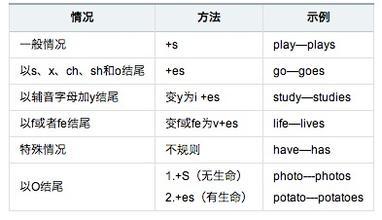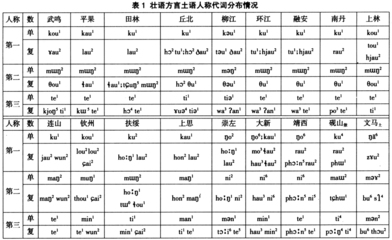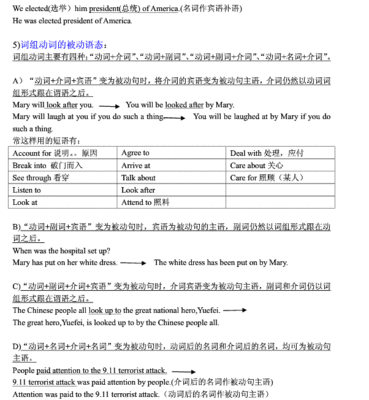第三人称单数问题
一般现在时中,当主语是第三人称单数时,即常在动词原形后加-s或-es。
第三人称单数变化,现归纳总结如下:
1.人称代词he, she, it是第三人称单数。如:
He likes watching TV.他喜欢看电视。
She has lunch at twelve.她十二点吃午餐。
It looks like a cat.它看起来像只猫。
2.单个人名、地名或称呼作主语;用第三人称单数。如:
①Han Mei looks like her mother.韩梅看起来像她的母亲。
②Beijing is in China.北京在中国。
③Uncle Wang often makes cakes.王叔叔经常做蛋糕。
3.单数可数名词或"this / that / the/ a +单数可数名词"作主语时,是第三人称单数。如:
①A horse is a useful animal.马是有用的动物。 ②This book isyours.这本书是你的。
③That car is red.那辆小汽车是红色的。 ④The cat is Lucy's.这只猫是露茜的。
4.不定代词someone, somebody, nobody, everything, something等及指示代词this,that作主语时,第三人称单数。
①Everyone is here.大家到齐了。 ②There is something wrong with thewatch.这块手表有毛病。
③This is a pen.这是一支钢笔。 ④That is an eraser.那是一块橡皮擦。
5.不可数名词作主语时为第三人称单数。如: ①The milk is in the glass. ②The bread is verysmall.
6.当数字或字母作主语时,看作第三人称单数。如: ①"6" is a lucky number."6" ②"I" is aletter.
发音规则
动词原形变第三人称单数的规则与发音规律同名词单数变复数大致相同,请认真观察。
1、大多数动词在词尾加“S”在清辅音后发音为[s],在浊辅音及元音后发音为 [z]。如:
①stop-stops [s] ; make-makes [s]
②read-reads [z] ; play-plays [z]
2、以辅音字母加“y”结尾的,要先将“y”变为“i”,然后在加“es”读[iz] 如:
fly-flies [z]; carry-carries [z]
study-studies [z]; worry-worries
3、以“s, x, ch, sh”结尾的,在词尾加“es”,发音为[iz] 如:
teach-teaches [iz]; watch-watches [iz]
4、以“o”结尾的动词,加“es”,读[z] 如:
go-goes [z] do-does [z]
注:下面几个动词变为单数时,原词的元音部分的发音发生了较大的变化,请注意记忆。 如:
1、do [du:]-does [dz]
2、say [sei]-says [sez]
以不发音字母“e”结尾的开音节词,如果尾音是[s],[z]时,加“s”后字母“e”发音, 与所加“s”
一起读做[iz]。 如:
close-closes [iz]
作业
I.写出第三人称单数:
wash_________ match _______guess______ study______ finish_________go________ snow______ carry_________
II.用所给动词的适当形式填空:
1. He________ TV every evening. (watch)
2. We always ________ to school on foot. (go)
3. Tom, with his classmates, often ______ footballafter school. (play)
4. Your shoes _______ under the bed. (be)
5. ______ here and ______ by me. (come, stand)
6. His uncle usually _________ to work by bus.(go)
7. I always ______ up at six in themorning.(get)
8. John ________ like his father. (look)
III.完成句子
根据所给中文意思,在空白处填入适当词语完成句子。每空一词,请直接在答题纸上完成,不要在此页上作答。
1.该吃晚饭了。
it’s time to ________ ________.
2.你想来点儿面包吗?
would you ________ some ________ ?
3.安娜太小,还不能上学。
ann is ________ young ________ go to school.
4.约翰跑得和我一样快。
john runs ________ fast ________ me.
5.布莱克太太经常在英语上帮助我们。
mrs. black often ________ us ________ our english .
6.老师让我们每天说英语。
the teacher tells us ________ ________ english every day.
7.为什么不让孩子们做他们喜欢的事情?
________ ________ let the children do what they like?
Key:
二、1. watches 2. go 3. plays 4. are 5. come, stand6. goes 7. get, got
8. looks
三、1. it’s time to have supper. 2. would you like somebread?
3. ann is too young to go to school. 4. john runs as fast asme.
5. mrs. black often helps us with our english.
6. the teacher tells us to speak english every day.
7. why not let the children do what they like?
一般现在时态
一、一般现在时的用法:
1、表示经常或者反复发生的动作. 如: 我每天吃午饭. I have lunch every day.
2、还表示现在存在的一种状态. 如:我姐姐是一位老师.My sister is a teacher.
3、客观真理,客观存在,科学事实。例如:The earth moves around the sun.地球绕着太阳转。
二、一般现在时态经常与often(经常)sometimes(有时)always(总是)usually(通常)等频率词连用,也经常与everyday(每天), every week(每周), every month(每月), every term(每学期), everyyear(每年), once a week (一周一次),twice a year(一年两次)等表示时间的词连用。
三、第三人称单数问题
一般现在时中,当主语是第三人称单数时,即常在动词原形后加-s或-es。
四、一般现在时分类:
1.一般现在时态分为be 动词的一般现在时。
1) be动词包括am,is,are. 中文为"是", 这三个词的用法要随着主语的变化而变化。 "am" 用于第一人称单数(I);"is" 用于第三人称单数(he,she,it); "are "用于第一人称复数(we),第二人称单数和复数(you),第三人称复数(they)。 可以记住以下顺口溜: am管 "我", is管",她,它,他", are管"大家"。
一般疑问句和否定句:把be 动词"am,is,are" 放在句首,回答时也要使用be动词;变为否定句时,把表示否定的not 放在"am is are" 的后面, 其中可以简写为:is not---- isn't ;are not---- aren't;amnot 没有简写形式。注意:如果are not, is not放在句尾时,不能使用简写,必须写出整个单词。.
Am I a teacher? Yes, I am. (No, I am not.) Are you his friend? Yes,you are. (No, you are not.)
Is she a nurse? Yes, she is. (No, she is not.)
否定句为:I am not a teacher. You are not his friend. She is not anurse.
2)实义动词的一般现在时如果句子的动词不是be 动词 "am is are" 而是其他实义动词,疑问句和否定句要借助于助动词"do"或者 "does", 也就是说be 动词和实义动词原形不能同时使用。 这里的"do","does" 本身没有什么意义,只是帮助构成疑问句和否定句. 一般疑问句读时必须用降调."do"和"does"的使用要随着人称的变化而变化。请看下面两组句子,注意区分他们的共同点和不同点。
I go to school every day. ------------- I don't go to school everyday.
He goes to school every day. ---- --------He doesn't go to schoolevery day.
Do you go to school every day? -----------Does he go to schoolevery day?
Yes, I do. (No, I don't) --------------Yes, he does. (No, hedoesn't)
当主语是第三人称单数时,
肯定句为:主语+动词的s形式+宾语
否定句为:主语+助动词doesn't+动词原形+宾语
疑问句为:Does+主语+动词原形+宾语
肯定回答和否定回答也要使用助动词does.
注:1)第三人称单数用了 does 后面就不用动词的s形式了,而用动词原形.
2)变为疑问句,要在句首加"do" ; 变为否定句, 要在动词前面加"do not", 可以简写为 "don't".
课堂练习
一、把下列句子改成一般疑问句并做肯定、否定回答。
1.I usually get up at six o’clock.
?
Yes,./No,.
2. We usually write e-mails to each other on Saturdayevening.
?
/.
3. They have the same hobby.
?
./.
4.Suhai and Su yang like listening to music after school.
?
./.
5.Helen usually watches TV in the evening.
?
. /.
二、用词的适当形式填空。
1.What time_________ his father_________(do) the work?
2.He _________(get) up at five o’clock.
3.__________ you _________(brush) your teeth every morning.
4.What ________ ( do ) he usually ________( do ) afterschool?
5.Tom ________ ( study ) English, Chinese, Maths, Science andArt at school.
6. Kitty sometimes __________(go) to the park with hissister.
7.At eight at night, she __________( watch ) TV with herparents.
8. ________ Mike________( read ) English every day?
9.How many lessons________ your classmates______( have ) onMonday?
10.We often___________ ( play ) football in the playground.
三.选择
( ) 1. _____ you have a book?
A. Do B. Are C. Is D. Have
( )2. They _________ on a farm.
A. working B. is work C. work D. is worked
( ) 3. Does Peter like to watch TV?
__________.
A. Yes, he like B. No, he doesn’t C. Yes, he’d like D. No, helikes
( )4. She doesn’t __________ her homework in the afternoon.
A. doing B. to do C. does D. do
( )5. How ____________ Mr. Brown ___________ to America?
A. do,go B. is,go C. does,go D. does,goes
( )6. Where’s my camera? I____________ it.
A. am not finding B. am not seeing C. can’t find D. can’t lookat
( )7. How ___________ he go to work?
He ___________ to work by bike.
A. does ;go B. do;goes C. do ;go D. does;goes
( )8. ______ you usually late for school?
No, _____________.
A. Do ; I am B. Does ;not C. Are ; I’m not D. Are ; Iaren’t
( )9. _____ she _____ home at six every day?
A. Is , leave B. Does , leave C. Is , leaves D. Does ,left
( )10. Mr. Yang ____________ English this term.
A. teachesour B. teaches us C. teachs us D. teach our
答案:二.1.does, do 2. gets 3. Do, brush 4. does, do 5. studies 6.goes 7. watches 8. Does, read 9. do, have 10. play
三.1---5 A C B D C 6---10 C D C B B
 爱华网
爱华网



